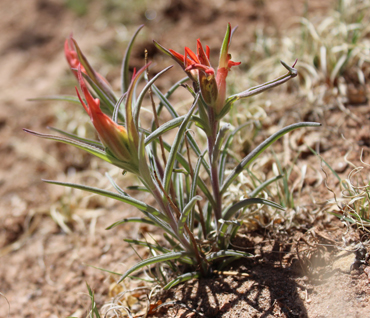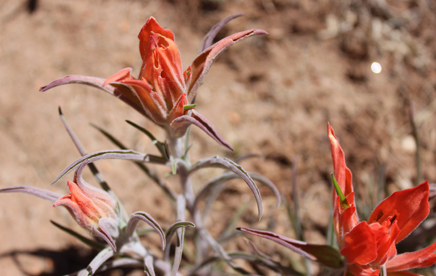
Location
Behind wall at Visitor Center (N35D33'01.049 X W105D41'10.361)
Flowers first observed: 4/10/17
The Plant w/Flowers

The Flowers

Distribution
"Found on dry rocky slopes from 4,500-10,500 ft (1372-3200 m); flowers March-October. AZ, NM, CO, w TX; n MEX." (SEINet)
Description
"Duration: Perennial Nativity: Native Lifeform: Subshrub General: Perennial with several stout stems, 10-40 cm tall, with woody rootstock, covered in tangled woolly hairs. Leaves: Linear to linear-lanceolate, entire, to 7 cm long, glabrous on the upper surface, tomentose to villous beneath. Flowers: Inflorescence a dense spike, usually elongating at anthesis; floral bracts obovate, scarlet to various shades of red, entire of some with linear lateral lobes; upper part of bract glandular-pubescent, lower part villous; calyx equally cleft on both upper and lower sides, yellow and villous except scarlet and glandular-pubescent at the apex; corolla 25-30 mm long, exserted, upper hood as long or shorter than corolla tube, green and glandular-pubescent with red scabrous margins, lower lip green, lobes very short. Fruits: Ovoid loculicidal capsule 10-14 mm long, with numerous seeds. Ecology: Found on dry rocky slopes from 4,500-10,500 ft (1372-3200 m); flowers March-October. Distribution: AZ, NM, CO, w TX; n MEX. Notes: One of the more widespread Castilleja found in the region. Distinguished by being perennial, having densely hairy stems, the bracts below flowers (often colored and resembling petals) being entire or toothed near the apex. Much like C. austromontana, but different with its smaller linear, entire leaves. In our region there are two varieties: var. gloriosa and var. integra. There is not much clarity as to the variety distinctions, so it is a worthy collection to make." (SEINet)
Ethnobotanical Uses
Food:
"The flowers of Indian paintbrush are edible, and were consumed in moderation by various Native American tribes as a condiment with other fresh greens. These plants have a tendency to absorb and concentrate selenium in their tissues from the soils in which they grow, and can be potentially very toxic if the roots or green parts of the plant are consumed. Highly alkaline soils increase the selenium levels in the plants. Indian paintbrush has similar health benefits to consuming garlic if only the flowers are eaten in small amounts and in moderation.[3] (Wikipedia)
"The Tewa also ate raw paintbrush blossoms. People from Tesuque report that the flower parts are still sucked for their nectar, much in the same way that older readers may have sucked honeysuckle and other blossoms in their youth." (Dunmire and Dunmire 213)
"Navajo Burn Dressing Plant used for burns. --- Gastrointestinal Aid Infusion of crushed leaves taken for stomach troubles. --- Navajo, Ramah Blood Medicine Compound decoction of root used to 'clean out the blood' after internal injury. Burn Dressing Poultice of leaves applied to burns. Gynecological Aid Decoction of leaf taken during pregnancy to keep baby small, for easy labor. --- " (Moerman 143)
Medicine:
The Ojibwe used a hairwash made from Indian paintbrush to make their hair glossy and full bodied, and as a treatment for rheumatism. The high selenium content of this plant has been cited as the reason for its effectiveness for these purposes. Nevada Indian tribes used the plant to treat sexually transmitted diseases and to enhance the immune system." (Wikipedia)
"Indians used an extract of the plant to treat kidney and skin disorders and a weak tea made from the plant was thought to be effective as a love potion." (Pierce and Pierce 49)
"Used for burns, an infusion taken for stomach troubles, as a blood medicine, as a dye, as a ceremonial decoration, and as a preservative when mixed with chile." (SEINet)
"Navajo Burn Dressing Plant used for burns. --- Gastrointestinal Aid Infusion of crushed leaves taken for stomach troubles. --- Navajo, Ramah Blood Medicine Compound decoction of root used to 'clean out the blood' after internal injury. Burn Dressing Poultice of leaves applied to burns. Gynecological Aid Decoction of leaf taken during pregnancy to keep baby small, for easy labor. --- " (Moerman 143)
"At Jemez it was said that mixing the flower bracts with chile seeds would prevent spoilage of the latter." (Dunmire and Tierney 213)
"As a diuretic, the Spanish New Mexicans wash and boil the plant well. A teaspoonful of sugar is added to the stained liquid, and this is drunk every two or three hours. And for inflammations of the skin and supposed cases of leprosy, two parts of ground flor de Santa Rita are mixed with one part of mashed cana agria roots (wild pieplant), and one part of powdered piedra lmbre (alum). Then this combination is sprinkled on the diseased places as a desiccant." (Moore 71)
"The Tewa prepared a bathing solution from the whole plant, the purpose of which was to alleviate the aches and pains that inevitably attend long outdoor ceremonies." (Dunmire and Tierney 213)
Other Uses:
"The most common historic use for paintbrush has been in conjunction with other plants to color deerskins red. It also was an ingredient, along with minerals, in the production of black paint. At Jemez it was said that mixing the flower bracts with chile seeds would prevent spoilage of the latter. The Tewa solution from the whole plant, the purpose of which was to alleviate the aches and pains that inevitably attend long outdoor ceremonies." (Dunmire and Dunmire 213)
"Apache, White Mountain Unspecified Root bark used with other substances to color various kinds of skins, especially deerskin. --- Zuni Black Root bark used with minerals to color deerskin black. ---" (Moerman 143)
"Jemez Preservative Dried bracts mixed with chile seeds to prevent spoilage during storage. --- Keres, Western Ceremonial Items Plant held by women for decoration during the harvest dance. ---" (Moerman 143)
"Children pull off the flowers and suck their honey, in the same way as they extract honey from clover and honeysuckle, ad when they hit the back of their hands with the painter's brush blossoms, there is a resultant pop like that of small paper bags that have been blown up with air." (Moore 71)
Internet Links